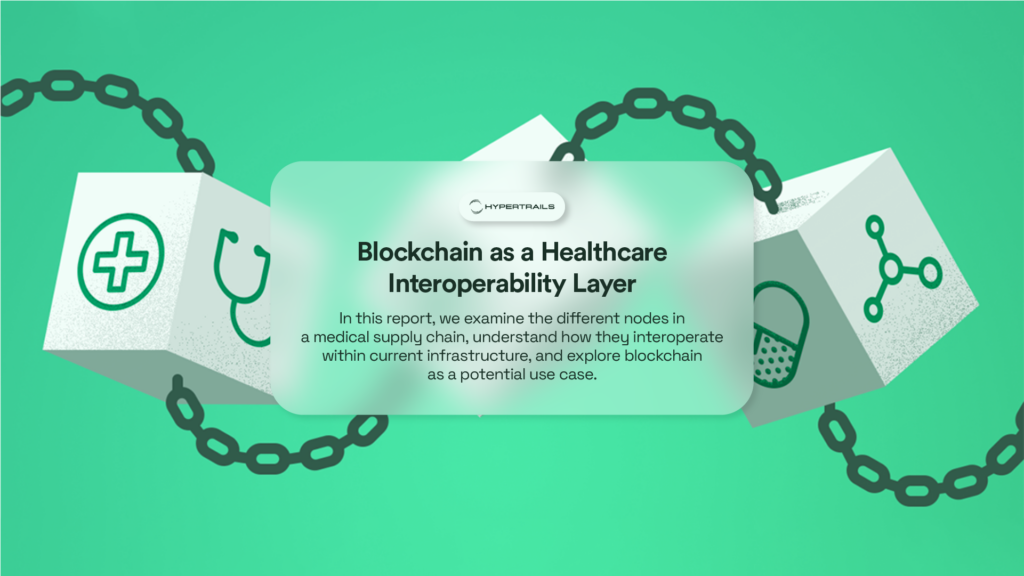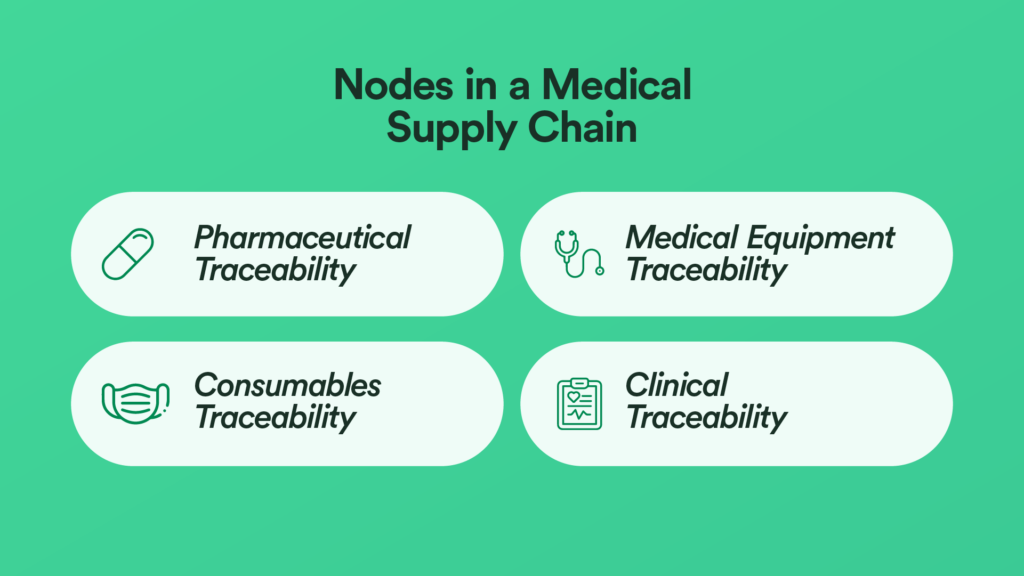Medical Supply Chain Traceability (MSCT) encompasses various interconnected pathways and impacts that collectively shape the healthcare delivery landscape. In this report, we examine the different nodes in a medical supply chain, understand how they interoperate within current infrastructure, and explore blockchain as a potential use case.

Nodes in a Medical Supply Chain
We examine the four main verticals of the medical supply chain: clinical traceability for biological specimens, pharmaceutical tracking for medications, medical equipment traceability for devices and instruments, and consumables tracking for high-volume disposable items, below.
Clinical Traceability
Clinical traceability is crucial for biological samples and diagnostic specimens. This encompasses the careful monitoring of blood, tissue, and urine samples as they move from collection points to analysis laboratories. Core attributes required from a system include the following:
- Temperature-controlled environments throughout transport
- Tamper-proof packaging and handling systems
- Real-time monitoring capabilities for early detection of contamination or degradation
- Comprehensive documentation of chain of custody
Pharmaceutical Traceability
The tracking of drugs and vaccines represents another critical node in the medical supply chain. This component focuses on monitoring the entire lifecycle of pharmaceutical products, from production through distribution to final administration. In response to evolving regulatory frameworks like the U.S. Drug Supply Chain Security Act (DSCSA), key aspects should include:
- Real-time location tracking and monitoring systems
- Batch and lot number management
- Expiration date tracking and alerts
- Temperature excursion monitoring and reporting
- Chain of custody documentation
- Authentication and verification protocols
Particular emphasis should be placed on maintaining cold chain requirements during vaccine shipping and ensuring the authenticity of pharmaceutical products to prevent counterfeit medications from entering the supply chain.
Medical Equipment Traceability
Medical equipment traceability focuses on the journey of devices from manufacturing facilities to point-of-use locations. Unlike pharmaceuticals and clinical samples, medical equipment requires lifecycle management across reuse cycles and maintenance periods, with distinct protocols for single-use versus reusable devices. This tracking encompasses critical items such as surgical tools and instruments, diagnostic equipment, medical implants, and prosthetics. Notably, with 20-30% of U.S. hospitals reporting reuse of at least one type of single-use device, robust traceability becomes even more critical.
- Asset Lifecycle Documentation: Serial numbers and UDI compliance for complete device history from manufacture to retirement, with particular attention to reprocessing records for facilities that handle single-use device reuse over the past two decades
- Maintenance Management: Detailed service records and preventive maintenance schedules, including standardized decontamination and reprocessing protocols, particularly crucial for reusable devices like endoscopes and dialysis machines
- Safety and Compliance: Comprehensive recall management system with proactive planning, real-time tracking capabilities, and post-recall analysis protocols to ensure continuous improvement in patient safety
Equipment traceability proves particularly valuable especially when managing recalls or tracking the maintenance history of critical care devices.
Consumables Traceability
The final node focuses on high-volume, disposable medical items essential for daily healthcare operations, such as surgical gloves, medical masks, and syringes. Unlike other medical supply chain components, consumables are characterized by their high turnover rates and immediate impact on daily operations, making volume-based tracking and just-in-time inventory management critical.
- Real-time inventory management to prevent stockouts of critical items
- Expiration date tracking for rotating stock effectively
- Quality assurance monitoring across large batch volumes
- Usage pattern analysis for supply chain optimization and demand forecasting
For these items, traceability systems help maintain appropriate stock levels while ensuring that no expired or compromised items reach patient care areas.

Interoperability in Medical Supply Chain
Continuing on from the discussion above, it is clear that there are multiple different aspects – depending on the sub-vertical – that need to be covered when implementing traceability systems across the medical supply chain. The complexity of coordinating these diverse requirements across clinical samples, pharmaceuticals, equipment, and consumables demands robust standardization.
As a result of this complexity two major organizations emerged as pioneers: GS1, providing global supply chain standards, and Health Level Seven International (HL7), focusing on healthcare information interoperability frameworks. Their collaboration, formalized through a landmark Memorandum of Understanding in 2007 and renewed in 2013, marked a pivotal shift toward integrated healthcare supply chain management.
GS1, as the primary global standards organization, has shaped the current landscape of healthcare standards which encompasses several complementary frameworks. GS1’s system provides foundational elements including Global Trade Item Numbers (GTIN) for unique product identification, Global Location Numbers (GLN) for facility tracking, and Electronic Product Code Information Services (EPCIS) for secure data sharing. These work alongside HL7’s healthcare information exchange protocols, enabling seamless communication between clinical systems and supply chain operations. ISO standards add another crucial layer, with ISO 13485 governing medical device quality management and ISO 9001 ensuring consistent quality processes. The WHO’s Policy Paper on Traceability of Medical Products has further emphasized the importance of global standardization for maximizing national and international interoperability.
Building upon these established frameworks, the integration of blockchain represents a new frontier in healthcare supply chain interoperability. The ISO Technical Committee on blockchain (ISO/TC 307) has developed standards that work alongside traditional quality management systems, addressing aspects such as terminology, reference architecture, security, and privacy.
The Blockchain as the Next Step
While established standards like GS1 and HL7 have created robust foundations for healthcare interoperability, the integration of blockchain technology presents an opportunity to address persistent challenges in pricing transparency and supply chain integrity. Through smart contracts, tokenization, and cryptographic verification, blockchain can enhance existing systems while introducing new capabilities for automation and trust. The following sections explore how this technology can be specifically implemented to transform healthcare operations, particularly in areas of pricing management and anti-counterfeiting measures.
Leveraging Smart Contracts for workflow/pricing execution
Healthcare pricing systems face a fundamental challenge: managing a complex ecosystem of price adjustments, discounts, and agreements across multiple stakeholders and systems. Traditional approaches rely on fragmented tools – spreadsheets, disconnected databases, and manual reconciliation processes – creating inefficiencies and opportunities for error.
Blockchain technology, specifically through smart contracts, offers a comprehensive solution to this fragmentation. The technical implementation leverages ERC1155, a sophisticated blockchain token standard that enables multiple token types within a single contract. This creates a unified system where each pricing component becomes a programmable, traceable unit. What makes ERC1155 particularly suitable is its semi-fungible nature – allowing it to simultaneously handle both fixed elements (like base price tokens) and variable components (such as dynamic pricing tiers, volume-based discounts, and contractual adjustments) while maintaining their distinct properties and relationships.
Such an implementation becomes particularly evident in Gross-to-Net (GTN) calculations, where multiple price adjustments – from chargebacks to rebates to administrative fees – must be tracked and reconciled. Each pricing adjustment becomes a verifiable transaction on the blockchain, creating an immutable audit trail of price evolution. The smart contracts governing these tokens can automatically execute complex pricing rules, ensuring that negotiated discounts, seasonal adjustments, and volume-based pricing are applied consistently and transparently across the entire healthcare network. This eliminates the opacity that traditionally plagues healthcare pricing while dramatically reducing reconciliation overhead and pricing disputes.
Product tokenization for Traceability
Building upon the smart contract foundation discussed above, the challenge extends beyond pricing to product authenticity itself. While traditional traceability systems rely on centralized databases, blockchain enables a more robust approach through digital product identity. The implementation uses ERC721 tokens – chosen specifically for their non-fungible properties that ensure each medical product maintains a unique, tamper-proof digital identity.
The technical architecture for such a system would need to combine multiple advanced cryptographic elements. One promising approach could leverage a BE-AC style traceability solution that integrates the BLAKE3 hash function with EdDSA (Edwards-curve Digital Signature Algorithm), potentially creating a verification system that balances security with scalability. This cryptographic foundation could be further enhanced through zk-SNARKs (Zero-Knowledge Succinct Non-Interactive Argument of Knowledge) protocols, enabling secure verification without compromising sensitive supply chain data.
Physical-to-digital binding can be achieved through unique identifiers like high-security QR codes or NFC tags, each tied to its NFT counterpart. Smart contracts automatically track state changes (manufactured, shipped, received, etc.) while maintaining a cryptographically secure chain of custody. Any deviation from the expected path or unauthorized attempt to create duplicate identifiers triggers immediate alerts across the network.
To ensure comprehensive security and traceability, the system could be structured around four distinct but interconnected layers:
- Layer 1: Physical identifiers (proposed implementation of tamper-evident labels with unique codes)
- Layer 2: Digital tokens (potential representation of each product unit)
- Layer 3: Verification protocol (suggested implementation of zk-SNARKs for privacy-preserving authentication)
- Layer 4: Consensus mechanism (proposed approach for ensuring network-wide agreement on product status)
Under such a system, each transfer of custody would become a verifiable transaction, potentially creating an unbroken chain of evidence from manufacturer to end user.
Integration with the GS1/HL7 layer
As we discussed above, for blockchain to be truly capable of adding value, it has to seamlessly work with the existing interop layers. For example, the hypothetical architecture we were ideating earlier could integrate naturally with HL7’s DFT (Detailed Financial Transaction) messages for pricing transparency and GS1’s EPCIS (Electronic Product Code Information Services) for product traceability. In this theoretical approach, the proposed BE-AC system’s enhanced BLAKE3-powered digital signatures could be embedded within HL7 V3’s XML structure, while the NFT-based product verification could leverage GS1’s GTIN (Global Trade Item Number) system as the foundational identifier. This creates a hybrid system where blockchain’s immutability complements, rather than replaces, established healthcare standards.
The integration becomes particularly powerful when considering RIM (Reference Information Model) compatibility with smart contracts. For example, a price adjustment triggered through a blockchain smart contract can automatically generate corresponding HL7 BAR (Billing Account Record) messages, ensuring that both the immutable blockchain record and traditional healthcare systems maintain synchronized states. This dual-layer approach ensures that organizations can gradually adopt blockchain capabilities while maintaining compliance with existing GS1 and HL7 protocols.
Conclusion
Medical Supply Chain Traceability represents a complex intersection of operational requirements, regulatory compliance, and technological innovation. The emergence of blockchain technology, particularly when integrated with established healthcare standards like GS1 and HL7, presents transformative opportunities for enhancing traceability, transparency, and trust across the medical supply chain.
